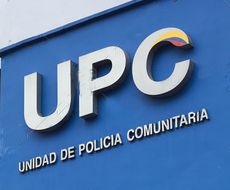 ABOUT OUR LOCAL POLICE STATION:
ABOUT OUR LOCAL POLICE STATION:
The local UPC station is small, with less than 20 seats in the meeting area, thus limiting space for large community safety meetings. Nine officers rotate duty at this station using only one squad car to cover a broad area from Las Tanuses and Cayo Ranch in the north, to Salite (the small tourist stop on the way to Pto. Lopez) in the south. The eastern edge of their territory goes from Cantagallo all the way to the waterfall midway on the Jipijapa road.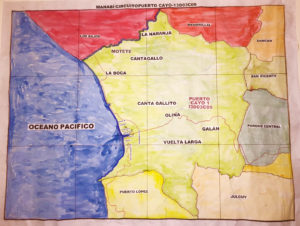
This is their territory map. Click on the image to enlarge:
COMMUNITY SAFETY MEETINGS:
REGISTER TO RECEIVE MEETING NOTIFICATIONS: Click Here
On Friday, August 3, 2016, members of the local police station (UPC) reached out to the in-town Puerto Cayo expat community to explore communication and safety measures.
In order to get more information to more people, the police suggested holding regular meetings, possibly monthly, so homeowners will stay informed and get questions answered. Meeting space may continue to be a challenge since the police may not leave their station.
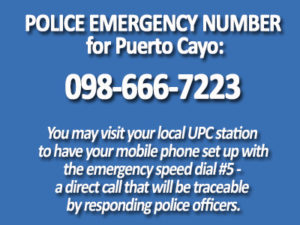 The police urged all local homeowners to stop by their office and have emergency speed dial #5 installed on their mobile phones. Should a homeowner encounter any in-home invasions or personal emergencies, this number will reach the police office immediately. The system will be demonstrated when you stop by, and you’ll learn what to do about false emergencies. We suggest bringing a bi-lingual speaker with you if your Spanish isn’t great.
The police urged all local homeowners to stop by their office and have emergency speed dial #5 installed on their mobile phones. Should a homeowner encounter any in-home invasions or personal emergencies, this number will reach the police office immediately. The system will be demonstrated when you stop by, and you’ll learn what to do about false emergencies. We suggest bringing a bi-lingual speaker with you if your Spanish isn’t great.
Click to read a COMPLETE GUIDE TO OPTIONS FOR POLICE EMERGENCY SERVICE
FOR MEDICAL EMERGENCIES: USE #911
NOTES FROM COMMUNITY SAFETY MEETING ON FRIDAY, APRIL 3, 2016
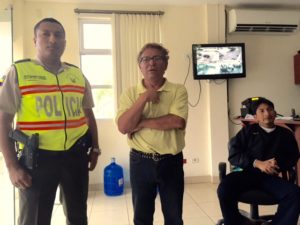 Appreciation to Representative Bryan Bakue, for organizing and Julius Mora, for translation.
Appreciation to Representative Bryan Bakue, for organizing and Julius Mora, for translation.
1. GET TO KNOW YOUR LOCAL POLICE: There are 9 police who rotate duties, 3 at a time. There is always at least one person at the UPC police station. It is worth taking your time to introduce yourself to these gentlemen and let them learn about your particular safety concerns. If your Spanish is not up to a lengthy conversation, make a point of taking a bi-lingual speaker with you.
2. NEIGHBORHOOD CRIME WATCH: Extranjeros who are planning on leaving their homes for a lengthy period of time are advised to register their absence with local police so they can keep an extra eye out. Also, if you are not there, and the police become aware of a break-in, they are able to enter your property legally (if you’ve given them permission.) Of course, you should also tell your neighbors.
3. RECENTLY CONVICTED THIEF: The young repeat offender thief who broke into so many local homes has been arrested and convicted and will be behind bars for some time. He had 3 prior convictions and received rehabilitative counseling each time. Now he has been sentenced to a much longer confinement, and we will not see him again for some time.
4. WHY DO PATROL CARS ALWAYS HAVE THEIR LIGHTS ON?
It is a police rule that officers’ cars must have their lights flashing when the car is moving. It alerts the community that they are being patrolled, but not harassed.
5. WHY DO PATROL CARS ALWAYS HAVE THEIR ENGINES RUNNING?
Again, this is a rule. Even if an officer stops for lunch, his car must be running. Cars can be tracked easily, and they are ready to go on immediate notice.
6. WHEN CAN POLICE ENTER A HOUSE TO INVESTIGATE: An officer can only enter a house to investigate if the home owner gives him permission. Exceptions to this rule are when life is in danger, domestic violence or when the general public safety is being threatened.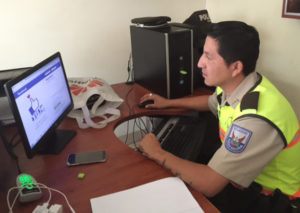
7. OTHER CITIZEN RIGHTS & PROTECTION QUESTIONS: Several specific personal questions were addressed at this first meeting. Citizens were always advised to gather photo and video evidence to support their claims.
In future meetings, police will again review how a crime is registered and tracked, and what kind of follow up is expected from victims.
